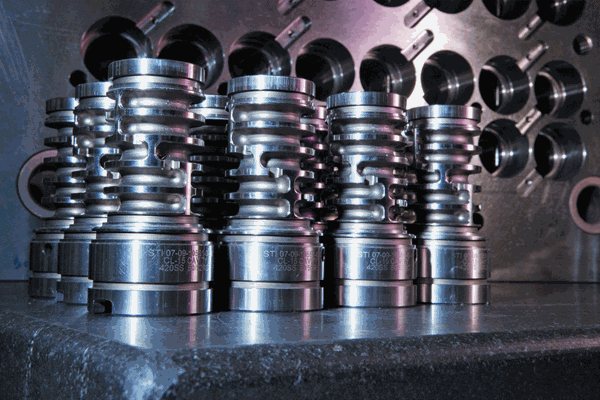Savings from the Front Lines: Rebuilding Saves Molders Money
This quarterly series features actual examples of a front-line mold building company presenting new approaches to improve the customer's profitability.
When the molders for a major medicine bottle manufacturer and a shampoo bottle top manufacturer were not reaching their production, quality or cycle time requirements for the molds, the company turned to Superior Tooling Inc. (Wake Forest, NC)—a manufacturer of plastic injection molds, blow molds, compression and die cast tooling, jigs and fixtures, stamping dies, and precision machine work for the medical packaging, aerospace, electrical, telecom, automotive, housewares and appliances markets.
According to Superior Tooling President Robbie Earnhardt, the 20-employee company prides itself on delivering tooling built to extremely close tolerances for high-quality plastic parts with very low cycle times. “We have been rebuilding tooling for the medical and packaging industries for years,” Earnhardt explains. “Most of these tools are worn, thus causing problems, and not running at full cavitation. Often the molder no longer has the original drawings or documentation for the molds, so we reverse engineer the molds to get this information. This is much more difficult than building a new mold. You don’t have the original information you need, the tool is already built and you have to obtain all of the information to match it back to the original dimensions. If you build a new tool you are designing it and giving it new dimensions and you know exactly what to do.”
The company first got into reverse engineering work through its mold repair jobs. “The more mold repair we did, the more knowledgeable we became about gathering and obtaining information,” Earnhardt notes. “Then we learned about—and starting doing—CMM measurement, which led us into doing reverse engineering.” The company has its own Reverse Engineering department, which is a division of its Engineering Department.
The Process
The molder of the shampoo lids contacted Superior Tooling to reverse engineer and rebuild the mold with its CMM equipment. “We create new models of the mold and a solid model from which we work to rebuild the tools,” Earnhardt elaborates. “Once that process is complete, we are able to give them up-to-date information and documentation on that tool. It is a fresh start for them.”
Superior Tooling kicks off this process with a customer meeting to look at the tool. “Then we bring it into the shop, disassemble it and look at the problems so we can get a better idea of what we are up against,” Earnhardt explains. “Then we quote it. Once that is done, we have continuous conversations with the customer (usually weekly) to update them where the tool is, what we have found, what we need to do, and different options we have to complete the job.”
Often Superior will review the mold, begin the reverse engineering process and start making some components while the customer is still running the mold. “Then we will bring the mold back in and fit the new components to it before doing the remaining work,” he states. “That cuts down their downtime.”
This job took about four weeks, Earnhardt adds. “Over the past year and a half we have rebuilt three very expensive tools for this customer,” he says. “These three molds would have probably cost approximately $750,000 to replace. By rebuilding, rather than replacing, these tools we have probably saved the customer about $500,000—maybe even more if you take out the extended costs of engineering, sampling and other processes that would have been required for a completely new tool.”
Earnhardt plans on Superior Tooling continuing to save its customers money with this reverse engineering niche. “This is a good spot for us,” he concludes. “It has allowed us to remain profitable when the industry was in a downturn.”
Related Content
Dynamic Tool Corporation – Creating the Team to Move Moldmaking Into the Future
For 40+ years, Dynamic Tool Corp. has offered precision tooling, emphasizing education, mentoring and innovation. The company is committed to excellence, integrity, safety and customer service, as well as inspiring growth and quality in manufacturing.
Read MoreMMT Chats: 4 Keys to a Successful Mold-Building Operation: Innovation, Transparency, Accessibility and Relationship
MoldMaking Technology Editorial Director Christina Fuges chats with Steve Michon, co-owner of Zero Tolerance in Clinton Township, Michigan, about the excitement of solving problems, the benefits of showing gratitude, the real struggle with delegation and the importance of staying on top of technology. This episode is brought to you by ISCAR with New Ideas for Machining Intelligently.
Read MoreEditorial Guidelines: Editorial Advisory Board
The Editorial Advisory Board of MoldMaking Technology is made up of authorities with expertise within their respective business, industry, technology and profession. Their role is to advise on timely issues, trends, advances in the field, offer editorial thought and direction, review and comment on specific articles and generally act as a sounding board and a conscience for the publication.
Read MoreWhat is Driving Mold Lifecycle Management Digitalization?
OEMs are looking to partner with suppliers to share and track data across the supply chain for advanced intervention and process management.
Read MoreRead Next
Reasons to Use Fiber Lasers for Mold Cleaning
Fiber lasers offer a simplicity, speed, control and portability, minimizing mold cleaning risks.
Read MoreHow to Use Strategic Planning Tools, Data to Manage the Human Side of Business
Q&A with Marion Wells, MMT EAB member and founder of Human Asset Management.
Read MoreAre You a Moldmaker Considering 3D Printing? Consider the 3D Printing Workshop at NPE2024
Presentations will cover 3D printing for mold tooling, material innovation, product development, bridge production and full-scale, high-volume additive manufacturing.
Read More






















